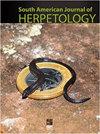高海拔的蜥蜴产卵率?玻利维亚地方性斑尾蠊病例
IF 0.7
4区 生物学
Q4 ZOOLOGY
引用次数: 0
摘要
摘要卵生是爬行动物中最普遍的生殖方式。南美洲Liolaemus属包括卵生和胎生两种,后者通常在高纬度和高海拔地区占主导地位。我们首次报道了玻利维亚特有的安第斯蜥蜴Liolaemus variegatus的卵细胞。我们在海拔高达4200米的提拉克山脉记录了它的存在,那里是世界上卵生蜥蜴最高的地方之一。我们描述了输卵管和流产卵的内容和流产卵的外壳结构。蛋壳厚度为66.7µm,由外层钙质层、厚纤维网和内层边界组成。钙质层中最丰富的矿物晶体构成了无形方解石沉积的基质,在外表面形成横向凹槽。在这些凹槽的底部是其他的伪六角形棱镜晶体,可能是文石,其中含有一些钾。计算机断层重建显示卵黄囊侧翼内有一个高密度的小区域。即使在光学显微镜下打开输卵管卵和流产卵,大多数胚胎也无法区分,这表明胚胎处于初期阶段。然而,来自两只雌性的输卵管卵处于胚胎期24-25。我们记录了一窝4-8个卵,占没有卵的雌性体重的96%。未来卵子形态的比较可能会揭示一些与从卵生到胎生过渡相关的生理变化。本文章由计算机程序翻译,如有差异,请以英文原文为准。
Lizard Oviparity at High Elevations?The Case of the Bolivian Endemic Liolaemus variegatus
Abstract. Oviparity is the most widespread reproductive mode among reptiles. The South American genus Liolaemus contains both oviparous and viviparous species, the latter generally dominating at high latitudes and high elevations. We report for the first time evidence suggesting oviparity in Liolaemus variegatus, an Andean lizard endemic to Bolivia. We record its presence at elevations up to 4,200 m on the Cordillera de Tiraque, which is among the highest localities for oviparous lizards in the world. We characterize the content of oviductal and aborted eggs and the structure of the shell of aborted eggs. Eggshell is 66.7 µm thick and is composed of an outer calcareous layer, a thick fibrous mesh, and an inner boundary. The most abundant mineral crystals in the calcareous layer constitute a matrix of formless calcite depositions forming transversal grooves on the outer surface. In the bottom of those grooves are other pseudo-hexagonal prism crystals that could be aragonite and which contain some potassium. Computed tomographic reconstructions revealed a small region of higher density inside a flank of the yolk sac. Most of the oviductal and aborted eggs had non-distinguishable embryos even after opening them under an optic microscope, suggesting that the embryos were incipient. However, the oviductal eggs from two females were at embryonic stages 24–25. We document clutches of 4–8 eggs, which comprise up to 96% of female body mass without eggs. Future comparisons of egg morphology may shed some light on the physiological changes associated with the transition from oviparity to viviparity.
求助全文
通过发布文献求助,成功后即可免费获取论文全文。
去求助
来源期刊
CiteScore
1.50
自引率
0.00%
发文量
10
期刊介绍:
The South American Journal of Herpetology (SAJH) is an international journal published by the Brazilian Society of Herpetology that aims to provide an effective medium of communication for the international herpetological community. SAJH publishes peer-reviewed original contributions on all subjects related to the biology of amphibians and reptiles, including descriptive, comparative, inferential, and experimental studies and taxa from anywhere in the world, as well as theoretical studies that explore principles and methods.

 求助内容:
求助内容: 应助结果提醒方式:
应助结果提醒方式:


